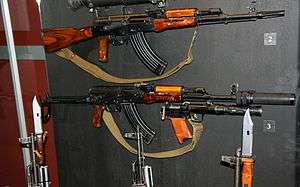AKM
| AKM | |
|---|---|
|
The AKM assault rifle | |
| Type | Assault rifle |
| Place of origin | Soviet Union |
| Service history | |
| In service | 1959–present |
| Used by | See Users |
| Wars |
Vietnam War Rhodesian Bush War Laotian Civil War Chadian–Libyan conflict Sino-Vietnamese War Soviet–Afghan War Iran–Iraq War 1982 Lebanon War Georgian Civil War First Chechen War Second Chechen War Russo-Georgian War Syrian Civil War Libyan Civil War War in Donbass Military intervention against ISIL |
| Production history | |
| Designer | Mikhail Kalashnikov |
| Designed | 1950s |
| Manufacturer |
Kalashnikov Concern Tula Arms Plant others |
| Produced | 1959–1977 (Soviet Union) |
| No. built | More than 10,278,300 |
| Variants |
AKMS AKMP AKML AKMLP AKMSP AKMSU AKMSN AKMSNP |
| Specifications (Updated information) | |
| Weight |
AKM: 3.1 kg (6.83 lb) w/unloaded magazine[1] AKML: 3.80 kg (8.4 lb) AKMS: 3.3 kg (7.3 lb) AKMSN: 3.77 kg (8.3 lb) AKMS: 3.8 kg (8.4 lb) with full magazine 30-rnd magazine: 0.33 kg (0.73 lb) 6H4 bayonet: 0.32 kg (0.71 lb) |
| Length |
AKM, AKML: 880 mm (34.6 in)[1] AKMS, AKMSN: 920 mm (36.2 in) stock extended / 655 mm (25.8 in) stock folded |
| Barrel length | 415 mm (16.3 in)[1] |
|
| |
| Cartridge | 7.62×39mm M43 |
| Action | Gas operated, rotating bolt |
| Rate of fire |
Cyclic rate of fire: 600 rds/min[1] Practical rate of fire: Semi-auto 40 rds/min[1] Full-auto 100 rds/min[1] |
| Muzzle velocity | 715 m/s (2,346 ft/s)[1] |
| Effective firing range | 350 m (383 yd)[1] |
| Feed system | 10, 20, or 30 round detachable box magazines. Also compatible with 40 round box magazines and 75-round drum magazines from the RPK. |
| Sights |
Rear sight notch on sliding tangent, front post 100–1,000 m sight adjustments Sight radius: 378 mm (14.9 in)[1] |
The AKM (Russian: Автомат Калашникова модернизированный, translit. Avtomat Kalashnikova modernizirovanniy, lit. 'Modernized Automatic Kalashnikov') is a 7.62mm assault rifle designed by Mikhail Kalashnikov. It is a common modernized variant of the AK-47 rifle developed in the 1940s.
Introduced into service with the Soviet Army in 1959, the AKM is the most ubiquitous variant of the entire AK series of firearms and it has found widespread use with most member states of the former Warsaw Pact and its African and Asian allies as well as being widely exported and produced in many other countries. The production of these Soviet rifles was carried out at both the Tula Arms Plant and Izhmash. It was officially replaced in Soviet frontline service by the AK-74 in the late 1970s, but remains in use worldwide.
Design details
The AKM is an assault rifle using the 7.62×39mm Soviet intermediate cartridge. It is gas operated with a rotating bolt. The AKM is capable of selective fire, firing either single shots or automatic at a cyclic rate of 600 rounds/min. Despite being replaced in the late 1970s by the AK-74 the AKM is still in service in some Russian Army reserve and second-line units and several east European countries.
Improvements over AK-47
Compared to the AK-47, the AKM features detail improvements and enhancements that optimized the rifle for mass production; some parts and assemblies were conceived using simplified manufacturing methods. Notably, the AK-47's milled steel receiver was replaced by a U-shaped steel stamping. As a result of these modifications, the AKM’s weight was reduced by ≈ 1 kg (2.2 lb), the accuracy during automatic fire was increased and several reliability issues were addressed. The AK-47's chrome-lined barrel was retained, a common feature of Soviet weapons which resists wear and corrosion, particularly under harsh field conditions and near-universal Eastern Bloc use of corrosively primed ammunition.
The AKM’s receiver, compared to the AK-47, is stamped from a smooth 1.0 mm (0.04 in) sheet of steel. To the U-shaped stamped sheet metal receiver housing a rear stock trunnion and forward barrel trunnion are fastened using rivets. The receiver housing also features a rigid tubular cross-section support that adds structural strength. Guide rails that assist the bolt carrier’s movement which also incorporates the ejector are installed inside the receiver through spot welding. As a weight-saving measure, the stamped receiver cover is of thinner gauge metal than that of the AK-47. In order to maintain strength and durability it employs both longitudinal and latitudinal reinforcing ribs.
Barrel
The forward barrel trunnion has a non-threaded socket for the barrel and a transverse hole for a pin that secures the barrel in place. On some models the rear trunnion has two extended mounting arms on both sides that support the buttstock; other fixed models use a stepped shaped trunnion that covers the full width of the inside of the receiver.
The AKM’s barrel is installed in the forward trunnion and pinned (as opposed to the AK-47, which has a one piece receiver with integral trunnions and a barrel that is screwed-in). Additionally the barrel has horizontal guide slots that help align and secure the handguards in place. To increase the weapon’s accuracy during automatic fire, the AKM was fitted with a slant cut muzzle brake that helps redirect expanding propellant gases upward and to the right during firing, which mitigates the rise of the muzzle during an automatic burst when held by a right-handed firer. The muzzle brake is threaded on to the end of the barrel with a left-hand thread. Not all AKMs had slant muzzle brakes; some were also fitted with the older muzzle nut which came from the AK-47. Most AKMs with muzzle nuts were older production weapons. The AKM's slant brake can also be used on the AK-47, which had a simple nut to cover the threads.
Gas block
The gas block in the AKM does not have a cleaning rod capture or sling loop but is instead fitted with an integrated bayonet support collar that has a cleaning rod guide hole. The forward sling loop was relocated to the front handguard retainer cap. The handguard retainer also has notches that determine the position of the handguards on the barrel. The AKM’s laminated wood handguards have lateral grooves that help securely grip the rifle.
Gas relief ports that alleviate gas pressure in the piston cylinder (placed horizontally in a row on the gas cylinder in the AK-47) were moved forward to the gas block and placed in a radial arrangement.
Bolt carrier
The AKM’s bolt carrier is slightly lighter in weight and, despite some minor differences in its shape, it can be used interchangeably with the AK-47’s bolt carrier and bolt.
Stock
The buttstock, lower handguard and upper heatguard are manufactured from birch plywood laminates like the later model AK-47 furniture.[2] Such engineered woods are stronger and resist warping better than the conventional one-piece patterns, do not require lengthy maturing, and are cheaper. The wooden buttstock used in the AKM is further hollowed in order to reduce weight and is longer and straighter than that of the AK-47, which assists accuracy for subsequent shots during rapid and automatic fire. The wooden stock also houses the issued cleaning kit, which is a small diameter metal tube with a twist lock cap. The kit normally contains the cleaning jag to which a piece of cloth material is wrapped around and dipped into cleaning solution. It also contains a pin punch, an assembly pin to hold the trigger, disconnector and rate reducer together while putting these back into the receiver after cleaning the weapon, and a barrel brush. The kit is secured inside the butt stock via a spring-loaded trap door in the stock's pressed sheet metal butt cap.
Spring
The AKM uses a modified return spring mechanism, which replaces the single recoil spring guide rod with a dual “U”-shaped wire guide.
Trigger assembly
The AKM has a modified trigger assembly, equipped with a hammer-release delaying device (installed on the same axis pin together with the trigger and disconnector) commonly called a "rate reducer". In fact its primary purpose is not to reduce the rate of automatic fire; it is a safety device to ensure the weapon will only fire on automatic when the bolt is fully locked, as the hammer is tripped by the bolt carrier's last few millimetres of forward movement. The device also reduces "trigger slap" or "trigger bounce" and the weapon’s rate of fire, which also reduces the dispersion of bullets when firing in fully automatic mode. The hammer was also changed and equipped with a protrusion that engages the rate reducer and the trigger has only one notched hammer release arm (compared to two parallel arms in the AK-47).[3][4]
Sights
The AKM’s notched rear tangent iron sight is calibrated in 100 m (109 yd) increments from 100 to 1,000 m (109 to 1,094 yd) and compared to the AK-47 the leaf’s position teeth that secure the sliding adjustable notch were transferred over from the right to the left edge of the ramp. The front sight is a post adjustable for elevation in the field and has a slightly different shape and its bottom portion is more narrow compared to the AK-47. Horizontal adjustment requires a special drift tool and is done by the armory before issue or if the need arises by an armorer after issue. The sight line elements are approximately 48.5 mm (1.9 in) over the bore axis. The "point-blank range" battle zero setting "П" on the 7.62×39mm AKM rear tangent sight element corresponds to a 300 m (328 yd) zero.[5] For the AKM combined with service cartridges the 300 m battle zero setting limits the apparent "bullet rise" within approximately −5 to +31 cm (−2.0 to 12.2 in) relative to the line of sight. Soldiers are instructed to fire at any target within this range by simply placing the sights on the center of mass (the belt buckle, according to Russian and former Soviet doctrine) of the enemy target. Any errors in range estimation are tactically irrelevant, as a well-aimed shot will hit the torso of the enemy soldier.[5]
Magazines
.jpg)
The early slab-sided steel AK-47 30-round detachable box magazines had 1 mm (0.039 in) sheet-metal bodies and weigh 0.43 kg (0.95 lb) empty.[6] The later steel AKM 30-round magazines had lighter sheet-metal bodies with prominent reinforcing ribs weighing 0.33 kg (0.73 lb) empty.[6][7] To further reduce weight a light weight magazine with an aluminum body with a prominent reinforcing waffle rib pattern weighing 0.19 kg (0.42 lb) empty was developed for the AKM that proved to be too fragile and the small issued amount of these magazines were quickly withdrawn from service. As a replacement steel-reinforced 30-round plastic 7.62×39mm box magazines were introduced. These rust-colored magazines weigh 0.24 kg (0.53 lb) empty and are often mistakenly identified as being made of Bakelite (a phenolic resin), but were actually fabricated from two-parts of AG-S4 molding compound (a glass-reinforced phenol-formaldehyde binder impregnated composite), assembled using an epoxy resin adhesive.[8][9][10] Noted for their durability, these magazines did, however, compromise the rifle's camouflage and lacked the small horizontal reinforcing ribs running down both sides of the magazine body near the front that were added on all later plastic magazine generations.[10] A second generation steel-reinforced dark-brown (color shades vary from maroon to plum to near black) 30-round 7.62×39mm magazine was introduced in the early 1980s, fabricated from ABS plastic. The third generation steel-reinforced 30-round 7.62×39mm magazine is similar to the second generation, but is darker colored and has a matte nonreflective surface finish. The current issue steel-reinforced matte true black nonreflective surface finished 7.62×39mm 30-round magazines, fabricated from ABS plastic weigh 0.25 kg (0.55 lb) empty.[11] Early steel AK-47 magazines are 9.75 in (248 mm) long, and the later ribbed steel AKM and newer plastic 7.62×39mm magazines are about 1 in (25 mm) shorter.[12][13]
The transition from steel to mainly plastic magazines yielded a significant weight reduction and allow a soldier to carry more rounds for the same weight.
| Rifle | Cartridge | Cartridge weight | Weight of empty magazine | Weight of loaded magazine | Max. 10.12 kg (22.3 lb) ammunition load* |
|---|---|---|---|---|---|
| AK-47 (1949) | 7.62×39mm | 16.3 g (252 gr) | slab-sided steel 430 g (0.95 lb) |
30-rounds 916 g (2.019 lb)[14] |
11 magazines for 330 rounds 10.08 kg (22.2 lb) |
| AKM (1957) | 7.62×39mm | 16.3 g (252 gr) | ribbed stamped-steel 330 g (0.73 lb) |
30-rounds 819 g (1.806 lb)[7][15] |
12 magazines for 360 rounds 9.83 kg (21.7 lb) |
| AK-103 (1994) | 7.62×39mm | 16.3 g (252 gr) | steel-reinforced plastic 250 g (0.55 lb) |
30-rounds 739 g (1.629 lb)[7][15] |
13 magazines for 390 rounds 9.61 kg (21.2 lb) |
Note: All, 7.62×39mm AK magazines are backwards compatible with older AK variants.
Note *: 10.12 kg (22.3 lb) is the maximum amount of ammo that the average soldier can comfortably carry. It also allows for best comparison of the three most common 7.62×39mm AK-style magazines.
Accessories

The AKM comes supplied with a different accessory kit that contains a M1959 6X4 or 6X3-type bayonet and comes with synthetic or steel magazines. The 6X3-type bayonet blade forms a wire-cutting device when coupled with its scabbard. The polymer grip and upper part of the scabbard provide insulation from the metal blade and bottom part of the metal scabbard, using a rubber insulator sleeve, to safely cut electrified wire. The kit also comes with a punch used to drive out various pins and a device that aids in assembling the rate reducing mechanism. The GP-25 Grenade launcher can also be fitted onto the AKM.
Ammunition
The weapon uses the same ammunition as the AK-47: the 7.62×39mm M43 intermediate rifle cartridge. The AKM mechanism's design principles and procedures for loading and firing are practically identical to those of the AK-47, the only difference being the trigger assembly (during the return stage of the bolt carrier on fully automatic mode) as a result of incorporating the rate reducer device.
Variants



The main variant of the AKM is the AKMS (S – Skladnoy – Folding), which was equipped with an under-folding metal shoulder stock in place of the fixed wooden stock. The metal stock of the AKMS is somewhat different from the folding stock of the previous AKS-47 model as it has a modified locking mechanism, which locks both support arms of the AKMS stock instead of just one (left arm) as in the AKS-47 folding model. It is also made of riveted steel pressings, instead of the milled versions of most AKS-47s.
The AKM was produced in the following versions: AKMP, AKML and AKMLP, whereas the AKMS led to the following models – AKMSP, AKMSN and AKMSNP. It is designed especially for use by paratroopers–as the folding stock permits more space for other equipment when jumping from a plane and then landing.
The AKMP rifle uses subdued Radium-illuminated aiming points integrated into the front and rear sight. These sights enable targets to be engaged in low-light conditions, e.g. when the battlefield is illuminated with flares, fires or muzzle flashes or when the target is visible as a shadow against an illuminated background. The sliding notch on the sight arm is then moved to the “S” setting (which corresponds to the “3” setting in the AKM). The sight itself is guided on the sliding scale and has a socket, which contains a tritium gas-filled capsule directly beneath the day-time notch. The tritium front post installs into the front sight base using a detent and spring.
The AKML comes equipped with a side-rail used to attach a night vision device. The mount comprises a flat plate riveted to the left wall of the receiver housing and a support bracket fixed to the mounting base with screws. To shield the light-sensitive photo detector plate of the night vision sight, the weapon uses a slotted flash suppressor, which replaces the standard recoil compensator. The AKML can also be deployed in the prone position with a detachable barrel-mounted bipod that helps stabilize the weapon and reduces operator fatigue during prolonged periods of observation. The bipod is supplied as an accessory and is carried in a holster attached to the duty belt.
The AKMN comes equipped with a side-rail used to attach a night vision device. The model designated AKMN-1 can thus mount the multi-model night vision scope 1PN51[16] and the AKMN2 the multi-model night vision scope 1PN58.[17]
The AKMLP is a version of the AKML with tritium sights (as in the AKMP).
The AKMSP rifle is based on the folding stock AKMS variant but fitted with tritium night sights, as in the AKMP.
The AKMSN model is derived from the AKMS and features an accessory rail used to mount a night vision sensor as seen on the AKML and additionally a flash hider and bipod. The left arm of the AKMSN’s folding stock is bent outwards in order to avoid the sight mount bracket during folding and the sling loop was moved further to the rear. Similarly to the AKMN-1, the AKMSN-1 can mount the multi-model night vision scope 1PN51[16] and the AKMSN2 the multi-model night vision scope 1PN58.[17]
A version of the AKMSN additionally supplied with factory tritium night sights is called the AKMSNP.
A version of the AKM with a modified lower handguard designed to accept the 40 mm wz. 1974 Pallad grenade launcher was developed in Poland and designated the karabinek-granatnik wz. 1974.
Semi-automatic trigger variant
The WASR-10 is a semi-automatic only variant developed from the AKM series rifle but is not another version rather a derivative or variant due to significant changes. The lack of the dimple over the magazine well is a peculiar WASR feature helpful in identification of WASR series rifles.[18] The WASR series are manufactured in Romania by the arms-maker Cugir and widely imported into the United States for the sporting gun market by importer Century International Arms who modifies them with Tapco of Georgia stocks.[19][20] Century began installing the TAPCO Intrafuse AK G2 trigger group in 2007 to eliminate bolt slap trigger finger injuries.[21]
Users


-
 Afghanistan[22]
Afghanistan[22] -
 Albania[23]
Albania[23] -
 Algeria[23]
Algeria[23] -
 Angola[23]
Angola[23] -
 Armenia[23]
Armenia[23] -
 Azerbaijan[23]
Azerbaijan[23] -
 Bangladesh[23]
Bangladesh[23] -
 Belarus[23]
Belarus[23] -
 Benin[23]
Benin[23] -
 Bolivia: Type 56 variant in use.[24][25]
Bolivia: Type 56 variant in use.[24][25] -
 Bosnia-Herzegovina[23]
Bosnia-Herzegovina[23] -
 Botswana[23]
Botswana[23] -
 Bulgaria: Produced locally.[23][26]
Bulgaria: Produced locally.[23][26] -
 Burkina Faso[27]
Burkina Faso[27] -
 Burundi[28]
Burundi[28] -
 Cambodia[23]
Cambodia[23] -
 Cameroon: Used by Cameroonian Peacekeepers in The Central African Republic.[29]
Cameroon: Used by Cameroonian Peacekeepers in The Central African Republic.[29] -
 Cape Verde[23]
Cape Verde[23] -
 Central African Republic[23]
Central African Republic[23] -
 Chad[23]
Chad[23] -
 Chile[30]
Chile[30] -
 Comoros[23]
Comoros[23] -
 Congo-Brazzaville[23]
Congo-Brazzaville[23] -
 Cuba: Produced locally under license.[23]
Cuba: Produced locally under license.[23] -
 Democratic Republic of the Congo[23]
Democratic Republic of the Congo[23] -
 Djibouti[22]
Djibouti[22] -
 East Germany: Produced locally. Examples include the MPi-KM (fixed stock) and MPi-KMS-72 (side-folding stock)[31]
East Germany: Produced locally. Examples include the MPi-KM (fixed stock) and MPi-KMS-72 (side-folding stock)[31] -
 Egypt: The Misr is an Egyptian copy of the AKM, manufactured by Factory 54 of the Maadi Company for Engineering Industries in Cairo for the Egyptian Army and for export sales.[32][33][34][35][36]
Egypt: The Misr is an Egyptian copy of the AKM, manufactured by Factory 54 of the Maadi Company for Engineering Industries in Cairo for the Egyptian Army and for export sales.[32][33][34][35][36] -
 Equatorial Guinea[23]
Equatorial Guinea[23] -
 Eritrea[23]
Eritrea[23] -
 Estonia: Still in limited military/police use. Replaced by AK-74.[23]
Estonia: Still in limited military/police use. Replaced by AK-74.[23] -
 Ethiopia[22]
Ethiopia[22] -
 Finland: Holds stocks of imported AKM clones for wartime reserve service (the Chinese Type 56 known as the RK 56 TP and the East German MPi-KM as the RK 72[37]) along with locally designed AK derivatives (the Rk 62 and the Rk 95 TP).
Finland: Holds stocks of imported AKM clones for wartime reserve service (the Chinese Type 56 known as the RK 56 TP and the East German MPi-KM as the RK 72[37]) along with locally designed AK derivatives (the Rk 62 and the Rk 95 TP). -
 Gabon[23]
Gabon[23] -
 Gambia: Used by Gambian Peacekeepers in Darfur.[38]
Gambia: Used by Gambian Peacekeepers in Darfur.[38] -
 Georgia[23]
Georgia[23]
-
 Ghana[40]
Ghana[40] -
 Guatemala[41]
Guatemala[41] -
 Guinea[23]
Guinea[23] -
 Guinea-Bissau[23]
Guinea-Bissau[23] -
 Guyana[23]
Guyana[23] -
 Hungary:[23] There is a Hungarian copy of the AKM called 'AK-63' manufactured by FÉG. The AK-63 comes with a fixed wooden or plastic stock, but there is a version with an under-folding metal stock called AK-63D.
Hungary:[23] There is a Hungarian copy of the AKM called 'AK-63' manufactured by FÉG. The AK-63 comes with a fixed wooden or plastic stock, but there is a version with an under-folding metal stock called AK-63D. -
 India[23] Various models of AKM and AKM style rifle in use. A local variant developed and manufactured by the Rifle Factory Ishapore.
India[23] Various models of AKM and AKM style rifle in use. A local variant developed and manufactured by the Rifle Factory Ishapore. -
 Iran[23] from Chinese manufactures
Iran[23] from Chinese manufactures -
 Iraq[23] from Soviet and Romanian manufactures
Iraq[23] from Soviet and Romanian manufactures
-
 Israel:[23] Captured from Arab armies over the course of the Arab-Israeli Conflict.
Israel:[23] Captured from Arab armies over the course of the Arab-Israeli Conflict. -
 Ivory Coast[43]
Ivory Coast[43] -
 Kazakhstan[23]
Kazakhstan[23]  Kenya: Kenyan police responding to the 2013 Westgate shopping mall shooting, seen armed with AKM and variant rifles.[44][45]
Kenya: Kenyan police responding to the 2013 Westgate shopping mall shooting, seen armed with AKM and variant rifles.[44][45]-
 Kyrgyzstan[22]
Kyrgyzstan[22] -
 Laos[23]
Laos[23] -
 Latvia[23]
Latvia[23] -
 Lebanon[46]
Lebanon[46] -
 Lesotho[23]
Lesotho[23] -
 Liberia[23]
Liberia[23] -
 Libya[23]
Libya[23] -
 Lithuania[23]
Lithuania[23] -
 Madagascar[23]
Madagascar[23] -
 Malawi[47]
Malawi[47] -
 Mali[23] – Armed and Security Forces of Mali
Mali[23] – Armed and Security Forces of Mali -
 Mauritania: Used by Mauritanian Military Police Peacekeepers in Ivory Coast.[48]
Mauritania: Used by Mauritanian Military Police Peacekeepers in Ivory Coast.[48] -
 Moldova[23]
Moldova[23] -
 Mongolia[23]
Mongolia[23] -
 Morocco[23]
Morocco[23] -
 Mozambique[23]
Mozambique[23] -
 Namibia[49]
Namibia[49] -
 Niger[50]
Niger[50] -
 Nigeria[23]
Nigeria[23] -
 North Korea: Type 68 variant.[23] The variant does not have a rate reducer.[51]
North Korea: Type 68 variant.[23] The variant does not have a rate reducer.[51] -
 Oman: Some captured from Dhofari rebels.[52]
Oman: Some captured from Dhofari rebels.[52] -
 Pakistan: Type 56 variant.[23]
Pakistan: Type 56 variant.[23] -
 Palestinian Authority: M70 variant[53]
Palestinian Authority: M70 variant[53] -
 Peru[23]
Peru[23] -
 People's Republic of China: Type 56 variant.[22]
People's Republic of China: Type 56 variant.[22] -
 Poland: Produced locally. Replaced by Kbs wz. 1996 Beryl and soon by MSBS.[26][31]
Poland: Produced locally. Replaced by Kbs wz. 1996 Beryl and soon by MSBS.[26][31] -
 Qatar[23]
Qatar[23] -
 Republic of Macedonia[23]
Republic of Macedonia[23] -
 Rhodesia: Captured AKM rifles were issued primarily to helicopter crews.[54]
Rhodesia: Captured AKM rifles were issued primarily to helicopter crews.[54] -
 Romania: Produced locally as the PM md. 63.[23][26]
Romania: Produced locally as the PM md. 63.[23][26] -
 Russia:[23] Still in limited military and police use. Officially replaced in most Russian military units by the AK-74. Some usage mainly in urban environments due to the ability to penetrate heavy cover.
Russia:[23] Still in limited military and police use. Officially replaced in most Russian military units by the AK-74. Some usage mainly in urban environments due to the ability to penetrate heavy cover. -
 Rwanda: Type 56 variant used by Rwandan Peacekeepers in The Central African Republic.[55]
Rwanda: Type 56 variant used by Rwandan Peacekeepers in The Central African Republic.[55] -
 São Tomé and Príncipe[23]
São Tomé and Príncipe[23] -
 Saudi Arabia[56]
Saudi Arabia[56] -
 Senegal[57]
Senegal[57] -
 Serbia[23]
Serbia[23] -
 Seychelles[23]
Seychelles[23] -
 South Sudan[22]
South Sudan[22] -
 Sierra Leone[23]
Sierra Leone[23] -
 Slovenia[23]
Slovenia[23] -
 Somalia[23]
Somalia[23]
-
 Soviet Union[22]
Soviet Union[22] -
 Sudan[23]
Sudan[23] -
 Suriname[23]
Suriname[23] -
 Swaziland[60]
Swaziland[60] -
 Sweden A small number of AKM's are used by the Swedish Armed Forces for familiarization training,[61] but they are not issued to combat units.
Sweden A small number of AKM's are used by the Swedish Armed Forces for familiarization training,[61] but they are not issued to combat units. -
 Syria[23]
Syria[23] -
 Tajikistan[23]
Tajikistan[23] -
 Tanzania[23]
Tanzania[23] -
 Togo[23]
Togo[23] -
 Turkey[23][62]
Turkey[23][62] -
 Turkmenistan[23]
Turkmenistan[23] -
 Uganda[63]
Uganda[63] -
 Ukraine[23] still in limited use, officially replaced in most Ukrainian military units by the AK-74. AKMS used by Ukrainian Security Service
Ukraine[23] still in limited use, officially replaced in most Ukrainian military units by the AK-74. AKMS used by Ukrainian Security Service -
 United Arab Emirates[23]
United Arab Emirates[23] -
 United States, captured rifles were used in Vietnam[64] and other conflicts.[65]
United States, captured rifles were used in Vietnam[64] and other conflicts.[65] -
 Uzbekistan[23]
Uzbekistan[23] -
 Venezuela Purchased in 2005[66]
Venezuela Purchased in 2005[66] -
 Vietnam[23] Chinese Type 56 variant and North Korean Type 68 variant. Standard infantry rifle of the Vietnamese Army.
Vietnam[23] Chinese Type 56 variant and North Korean Type 68 variant. Standard infantry rifle of the Vietnamese Army.
 South Vietnam, the ARVN were supplied with captured AKM rifles.[64]
South Vietnam, the ARVN were supplied with captured AKM rifles.[64]
-
 Yemen[23]
Yemen[23] -
 Yugoslavia: Several variants based on the AKM built by Zastava Arms factory, most notably the M70 and M70B.[67]
Yugoslavia: Several variants based on the AKM built by Zastava Arms factory, most notably the M70 and M70B.[67] -
 Zambia[23]
Zambia[23] -
 Zimbabwe[23]
Zimbabwe[23]
See also
- AK-74
- RPK
- List of Russian weaponry
- List of assault rifles
- Comparison of the AK-47 and M16
- Saiga semi-automatic rifle
References
- 1 2 3 4 5 6 7 8 9 https://web.archive.org/web/20110718231355/http://www.izhmash.ru/eng/product/akm.shtml AKM (AK-47) Kalashnikov modernized assault rifle, caliber 7.62mm
- ↑ "Type 2 & Type 3 AK-47". Retrieved 18 October 2016.
- ↑ Poyer 2006, pp. 8–11.
- ↑ Edward Ezell (1 March 1986). The AK47 story: evolution of the Kalashnikov weapons. Stackpole Books. p. 36. ISBN 978-0-8117-0916-3.
- 1 2 Gordon Rottman (24 May 2011). The AK-47: Kalashnikov-series Assault Rifles. Osprey Publishing. pp. 42–. ISBN 978-1-84908-835-0. Retrieved 24 December 2011.
- 1 2 Dockery, Kevin (2007). Future Weapons. p. 102. ISBN 0425217507.
- 1 2 3 "Ak 47 Technical Description - Manual". Scribd.com. 2010-09-30. Retrieved 2012-08-23.
- ↑ "Kalashnikovs 3 of the best" (PDF). "Shotgun News" magazine, Vol. 59 Issue no. 12 - May, 2005. Retrieved 10 April 2015.
- ↑ "Elastic characteristics of AG-4S glass-reinforced plastic under short-time and long-time loads". VM Grezin - Mechanics of Composite Materials, 1966 - Springer. Retrieved 10 April 2015.
- 1 2 Kokalis, 49
- ↑ "фициальный сайт группы предприятий "ИЖМАШ"". Archived from the original on 6 October 2014. Retrieved 2 October 2014.
- ↑ Rifle Evaluation Study, United States Army, Combat Development Command, ADA046961, 20 Dec 1962
- ↑ "Are kalashnikov magazines as robust as their reputation? He tormented a selection of AR magazines last year, now he takes on the AK. The results you may find surprising.". Retrieved 2 October 2014.
- ↑ Dockery, Kevin (2007). Future Weapons. p. 102. ISBN 0-425-21750-7.
- 1 2 Dockery, Kevin (2007). Future Weapons. p. 102.
- 1 2 ИЗДЕЛИЕ 1ПН51 ТЕХНИЧЕСКОЕ ОПИСАНИЕ И ИНСТРУКЦИЯ ПО ЭКСПЛУАТАЦИИ [PRODUCT 1PN51 TECHNICAL DESCRIPTION AND OPERATING INSTRUCTIONS] (in Russian). January 1992. pp. 11, 16.
- 1 2 ИЗДЕЛИЕ 1ПН58 ТЕХНИЧЕСКОЕ ОПИСАНИЕ И ИНСТРУКЦИЯ ПО ЭКСПЛУАТАЦИИ [PRODUCT 1PN58 TECHNICAL DESCRIPTION AND OPERATING INSTRUCTIONS] (in Russian). February 1991. pp. 5, 12–13.
- ↑ Big Mike's Hobby Channel (25 September 2015). "AK Comparison - SAR 1 vs WASR 10". Retrieved 18 October 2016 – via YouTube.
- ↑ "Gun Review: Century Arms WASR-10 (Romanian AK) - The Truth About Guns". 21 May 2010. Retrieved 18 October 2016.
- ↑ "Century's GP WASR-10". 15 October 2013. Retrieved 18 October 2016.
- ↑ "Archived copy". Archived from the original on 2015-05-16. Retrieved 2016-07-29.
- 1 2 3 4 5 6 7 Rottman, Gordon (2011). The AK-47 Kalashnikov series assault rifles. Great Britain: Osprey Publishing. ISBN 978-1-84908-461-1.
- 1 2 3 4 5 6 7 8 9 10 11 12 13 14 15 16 17 18 19 20 21 22 23 24 25 26 27 28 29 30 31 32 33 34 35 36 37 38 39 40 41 42 43 44 45 46 47 48 49 50 51 52 53 54 55 56 57 58 59 60 61 62 63 64 65 66 67 68 69 70 71 72 73 74 Jones, Richard D. Jane's Infantry Weapons 2009/2010. Jane's Information Group; 35 edition (January 27, 2009). ISBN 978-0-7106-2869-5.
- ↑ Army Recognition. "Bolivia Land Forces military equipment and vehicles Bolivian Army". armyrecognition.com. Retrieved 2017-08-08.
- ↑ (in Korean) 밀짤 게시판 (2014-03-24). "볼리비아군 사진들". naver.com. Retrieved 2017-08-08.
- 1 2 3 Personal infantry weapons: old weapons or new hardware in the coming decades? – Free Online Library. Thefreelibrary.com. Retrieved on 2014-04-20.
- ↑ US Army Africa (2014-05-24). "Burkina Faso Counter Terrorism Company receives training and equipment". US Army Africa. Retrieved 2017-06-12.
- ↑ Thierry Vircoulon (2014-10-02). "Insights from the Burundian Crisis (I): An Army Divided and Losing its Way". International Crisis Group. Retrieved 2017-06-12.
- ↑ UNMINUSCA (2017-05-30). "BF6V2537". UN Mission in the Central African Republic MINUSCA. Retrieved 2017-06-12.
- ↑ Gander, Terry J.; Hogg, Ian V. Jane's Infantry Weapons 1995/1996. Jane's Information Group; 21 edition (May 1995). ISBN 978-0-7106-1241-0.
- 1 2 Modern Firearms – AK-47 AKM. World.guns.ru. Retrieved on 2014-04-20.
- ↑ "Maadi Company for Engineering Industries (Factory 54) Special Weapons Facilities – Egypt". Fas.org. Retrieved 2009-11-20.
- ↑ John Pike (2005-04-27). "Maadi Company for Engineering Industries (Factory 54)". Globalsecurity.org. Retrieved 2009-11-20.
- ↑ "Exhibits Page 16". Avtomats-in-action.com. Archived from the original on 25 December 2009. Retrieved 2009-11-20.
- ↑ Jeff Freeman. "Egyptian Rifles". Home.comcast.net. Retrieved 2009-11-20.
- ↑ "Search the Small Arms Survey Website and Resources [Results for Misr]". Small Arms Survey. Geneva, Switzerland: Graduate Institute of International and Development Studies. Retrieved 17 June 2014.
- ↑ "Puolustusvoimat: Kalustoesittely". Mil.fi. 2009-05-20. Retrieved 2009-11-20.
- ↑ Albert Gonzalez Farran (2014-05-26). "Launch of the DIDC Committee". UNAMID. Retrieved 2017-06-04.
- ↑ Mettsel, Mikhail (2014-11-24). "Collective defense partnership: Russia, Abkhazia sign alliance". Russia Today. Retrieved 2017-08-05.
- ↑ Army Recognition (2013-02-09). "Ghana Ranks and combat uniforms Ghanaian Army". Army Recognition. Retrieved 2017-06-14.
- ↑ World Armies (2011-12-06). "Guatemalan Special Forces". flicker.com. Retrieved 2017-04-06.
- ↑ Osie Greenway. "Kurdish Peshmerga forces of 10th Brigade 3rd Battalion prepare to defend a newly adopted base they arrived at a week ago days after the Islamic State militants offensive swept through Iraq.". Osie Greenway. Retrieved 2017-07-04.
- ↑ Richelle Carey (2017-01-08). "Behind Ivory Coast's army mutiny". Al Jazeera News. Retrieved 2017-06-14.
- ↑ "Gunmen Kill Dozens in Terror Attack at Kenyan Mall". New York Times.com. 2013-09-21. Retrieved 2017-06-14.
- ↑ "Gunmen attack mall in Kenya". NBS News.com. Retrieved 2017-06-14.
- ↑ Maya Mikdashi (2011-02-15). "Tunisia, Egypt, Lebanon?". Jadaliyya. Retrieved 2017-06-15.
- ↑ Bright Malenga (2017-02-17). "MDF calls for applications from aspiring soldiers". Malawi 24. Retrieved 2017-06-14.
- ↑ ONUCI .ORG (2016-08-10). "LE DRSSG, BABACAR CISSE A PRESIDE A BOUAKE, LA CEREMONIE DE REMISE DE MEDAILLES A 140 ELEMENTS DE LA GARDE NATIONALE MAUROTANIENNE ET DIX POLICIERS DE LA COMPOSANTE DES NATIONS UNIES.(UNPOL)". ONUCI .ORG. Retrieved 2017-06-12.
- ↑ Nampa (2016-08-26). "Today's enemies are invisible – Geingob". the namibian. Retrieved 2017-06-14.
- ↑ THE ASSOCIATED PRESS (2015-04-27). "Boko Haram attacks Niger Army base". arab news. Retrieved 2017-06-14.
- ↑ US Department of Defense, North Korea Country Handbook 1997, Appendix A: Equipment Recognition, TYPE-68 (AKM) ASSAULT RIFLE, p. A-77
- ↑ McNab, Chris (2002). 20th Century Military Uniforms (2nd ed.). Kent: Grange Books. ISBN 1-84013-476-3.
- ↑ Palestinian security men, Hamas gunmen killed in West Bank clashes_English_Xinhua. News.xinhuanet.com (2009-05-31). Retrieved on 2014-04-20.
- ↑ Neil Grant (2015). Rhodesian Light Infantryman: 1961-1980. Osprey Publishing. p. 26. ISBN 1472809629.
- ↑ UNMINUSCA (2017-05-29). "BF6V1729". UN Mission in the Central African Republic MINUSCA. Retrieved 2017-06-12.
- ↑ Find Imagery Archived December 15, 2010, at the Wayback Machine.. DefenseImagery.mil. Retrieved on 2014-04-20.
- ↑ Emanuelle Landais (2016-02-29). "IUS led Flintlock counter-terrorism exercises end in Senegal". dw.com. Retrieved 2017-06-15.
- ↑ (in Somali)Garoowe (2016-12-08). "Daawo Sawirada: Qaabka ay Ciidamada Puntland ula wareegen Qandala". Caasimada Online. Retrieved 2017-07-04.
- ↑ (in Somali)Haldoor News (2016-05-09). "Ciidamada Qaranka Somaliland Oo Dhoolatus Balaadhan Ka Sameeyay Hargeisa Iyo Diyaar Garawga 18 May Oo Ay Ka Qayb Qaadan Doonaan". Haldoornews.com. Retrieved 2017-08-06.
- ↑ WELCOME DLAMINI (2013-05-30). "Army to recruit more soldiers". Times of Swaziland. Retrieved 2017-06-15.
- ↑ M16 M16a2 Kalashnikov Ak-47 – Utländska Vapensatsen. SoldF.com. Retrieved on 2014-04-20.
- ↑ "Kalashnikov AKM". Military Factory. Retrieved 4 June 2014.
- ↑ Reuters (2013-05-27). "Ugandan army chief fired after leaked letter". Aljazeera. Retrieved 2017-06-05.
- 1 2 Col. Michael Lee Lanning (1988). Inside the LRRPs: Rangers in Vietnam. Presidio Press. ISBN 0804101663.
- ↑ Walter J. Boyne (2003). Operation Iraqi Freedom: What Went Right, What Went Wrong, and Why. p. 110. ISBN 0765310384.
- ↑ Pike, John. "Venezuela Ground Forces or Army (Fuerzas Terrestres or Ejercito)". Retrieved 18 October 2016.
- ↑ "Automatic Weapon Family – cal. 7.62x39mm". Zastava-arms.co.rs. Archived from the original on June 24, 2009.
External links
| Wikimedia Commons has media related to AKM. |
- Modern Firearms article
- На замену АК-47…Юрий Пономарёв (in Russian)


